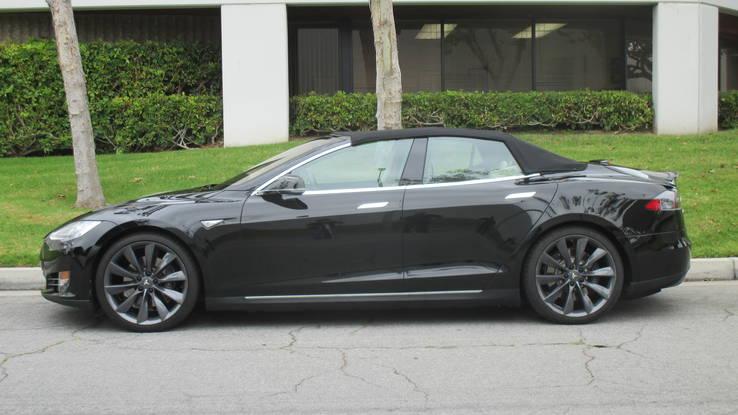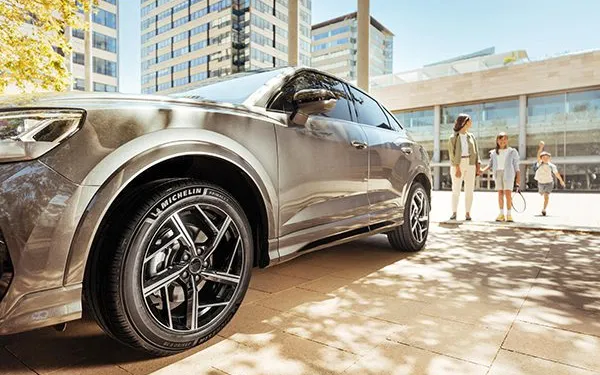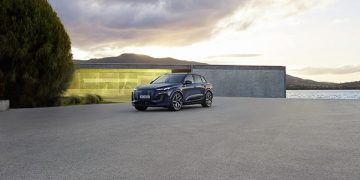Newport Convertible Engineering can chop the top off just about anything, and does
The first Tesla was a convertible, the Tesla Roadster. So why shouldn’t the Model S also offer a retractable roof?
Well, because it’s a four-door sedan with A-, B- and C-pillars, for one. And it is a hatchback, for another. And because convertible tops are kind of difficult to engineer, for a third.
But none of that stopped Newport Convertible Engineering from making one. In fact, they’ve made eight so far and are capable of making others. Buy all you want, they’ll make more.
We got a chance to climb into and drive a finished Tesla Model S convertible at Newport Convertible Engineering’s office (which is, ironically, in Huntington, not Newport, Beach, but that’s slightly more prestigious than their previous office in Placentia). We have driven cars from these guys before, most recently a Chrysler 300C a few years ago when those were a little more popular.

Newport Convertible Tesla
Our first view of the Tesla project car came with the top down. It stacks behind the rear seat in a big pile that blocks rear vision from the driver’s seat. It looked a little like one of those original Beetle convertibles. The top could stack lower, but there is the problem of the rear shock towers, which are located right there in the corners. The shock tower location necessitates that everything to do with the top be built around them. This encroaches on rear-seat shoulder room, but not too much else. You can still seat three across in the rear seat, but they have to be a very skinny three. Newport could engineer a new rear suspension that allows for a lower top stack on the Tesla, and has such plans in the books should any customer want to pursue that avenue, but such a deal would be cost-prohibitive.
Likewise the B-pillars have to stay, connected by a basket-handle structural bar. Leaving the B-pillar in place allows Newport Convertible Engineering to keep the same rear doors and windows.
“We can chop (the B-pillar) off but then we’d have to enlarge the rear doors and windows,” said Newport Convertible Engineering’s COO Matthew Kahnamelli. “The cost has got to be feasible.”
Other NCE projects have eliminated the B- and C-pillars, so it can and has been done. But the cost would exceed the $ 49,000 price of the Tesla Model S conversion we drove.
It probably doesn’t alter the crashworthiness of the car, either. Said Kahnamelli, ” The Tesla custom convertible has not gone through crash testing. All our convertible vehicles, including the Tesla convertible, go through structural reinforcement along the rocker panels, front header reinforcement, A-, B-, C-pillars including the trunk reinforcement, without modifying the original existing chassis and would not allow any original functions within the vehicle to become inoperable, ie: seat belts, audio, navigation, satellite, windows, windshield, brake system and front console computer system.”
The rear glass hatch on the Tesla was replaced with an aluminum decklid of NCE’s design and construction. It looked downright OEM, all the way to the CHMSL. There is a glass rear window in the folding soft top but even that looks like an OE project, with heated defroster and snug-fitting molding.

Top up on Newport Convertible’s Tesla
Climbing into the car, we found no reduction in front seat head- leg- or shoulder room. In fact, all the electronic infotainment and all the functions of that huge Tesla screen that dominates the dash were still fully functional.
The electrically operated top closes via a button on the dash and is finished off with two easy-to-use manual latches on the edges of the header. A power-latching system is available for more dinero.
We started off our drive with the top up. First thing we noticed is the solid structural rigidity. This is no Fox-bodied Mustang convertible. Crossing a couple rain gutters, the whole car stays stiff, and there’s no squeaking or creaking to indicate a decline in torsional rigidity. We found the same stiff bodies on other NCE convertibles we’ve driven in the past. Reinforcements are added around the door sills, pillars and window frame, though Kahnamelli didn’t say exactly where. We have seen frame stiffening on other NCE projects and saw some projects underway in the shop when we visited, so structural rigidity isn’t something to worry about with one of these.
There was a little wind noise underway with the top up, but it turned out to be caused by just one rear corner flap that hadn’t been snapped down before we left. Otherwise, wind noise is muted well.
We pulled over and quickly and easily dropped the top. There went rear vision, but you can’t have everything. At speed there’s no buffeting inside the cabin — we didn’t get on the freeway, but at up to 50 mph, there is very little wind intrusion. You can argue about the aesthetic appeal of the design, but functionally — apart from rear vision — it was solid.
Newport Convertible Engineering makes all kinds of cars into cabriolets. In the shop during our visit was a beautiful Ferrari 599, for instance. Because of the rear suspension on that car, the top fit perfectly flush beneath the deck. NCE added a hard tonneau cover to the design for when the top is down. Other conversions on hand included a couple of modern Toyota FJ Cruisers, a conversion that has been done by NCE about 200 times since 2009, according to Kahnamelli. A four-door Range Rover was being made into a two-door drop top while we were there and a Lexus LX 570 convertible had just left the premises. In addition there were several classic cars undergoing cabriolization: a 1959 Cadillac, ’57 Cadillac, ’57 Pontiac Star Chief, a 1980 Seville and a late-’50s/early-’60s Bentley. We didn’t get prices on those conversions, but Kahnamelli said that a lot of their work gets sent overseas.
Tesla itself has announced no plans for a convertible Model S, so if you want one, NCE is your best bet.



























